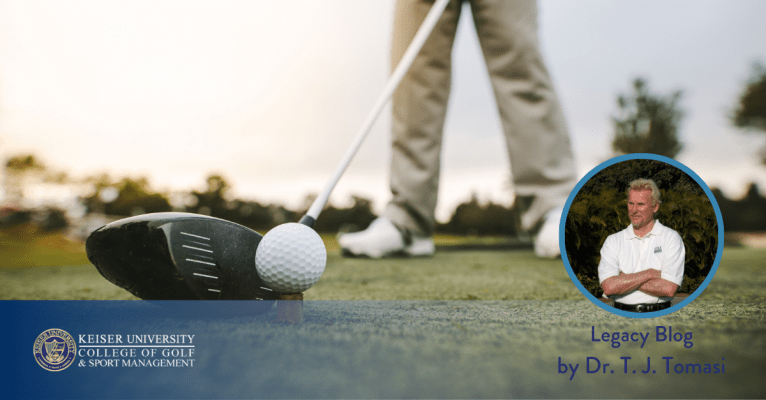To be a Good Player You Must “Own” the Clubface

A Legacy Post by Keiser University College of Golf Senior Faculty and Director of Research Dr. T. J. Tomasi (1940-2023)
What Clubface Control Really Means—and Why It Matters
One of the biggest differences between amateur golfers and great ball strikers comes down to how well they control the clubface. It’s not just about power—it’s about precision. When you can manage the clubface throughout the swing, your chances of hitting accurate, repeatable shots go way up.
In my opinion, of the great players, Ben Hogan had the most clubface control – but it wasn’t always that way; i.e., Hogan wasn’t always “Hogan.” Early in his career, he called himself ‘the terror of the field mice’ because he had an uncontrollable duck hook that got low and left in a hurry. After going broke on tour, it became clear to him that he couldn’t cash a ticket with that ‘snake in the bag.’ But through hard work on the range, “I found it in the dirt” he said, he came to understand clubface control, and in 1957, Hogan wrote what would become the most influential golf instruction book ever – Five Lessons – in which he outlined three keys to clubface control:
- Keeping the elbows pointing down to the ground
- Keeping them the same distance apart during the swing and
- Keeping the top of the arms in contact with the chest so they move together.
But Hogan wasn’t the only sharpshooter who demonstrated clubface control. So accurate was Calvin Peete that they called him Peete and Re-Peete. When he was 11, he fell out of a tree and broke his left arm in three places. However, it never healed correctly, so his forearm couldn’t rotate, and neither could the clubface. In 1966, at age 23, he played his first game of golf and qualified for the PGA tour a mere seven years later – then, over a 20+ year career, he won 12 times and led the PGA Tour in driving accuracy for 10 consecutive seasons.
And a few years later, there was another player (Tim Clark) who also had issues with his lead forearm – a congenital problem that made it difficult for the 2010 Player’s Champion to pronate or rotate his left palm toward the ground, so his clubface was protected against excess rotation. Tiny Tim (5’7”, 165 pounds) averaged 69 strokes per round in 2009, an impressive feat that demonstrated the value of clubface stabilization. Remember that the clubface determines 75-90% of the initial ball direction, depending on the club, so if you want to be accurate, you must find a way to “own” your clubface.
Try This to “Own” Your Clubface.
First, keep your elbows close together. Most amateurs have elbows that separate as they swing, and that forces the clubface to point off the swing arc so that depending on split-second compensations, the impact is never the same twice in a row. By keeping your elbows close together, especially in the downswing, you’ll find it’s much easier to have a repetitive motion. Next, feel as if your elbows are always pointing at the ground, stabilizing the face so it doesn’t spin. Thirdly, velcro your triceps to your pecs.
The Drill: Hit some balls with a belt or elastic tubing tied around your arms just above the elbows to keep them close to one another. Start with some 60- to 80-yard wedges to get the feel of having your elbows close together with a quiet face. Once you get used to the feeling, hit some full shots with a driver.
To feel a connection, place a head cover or a towel under your arms, then keep it there with light pressure all the way to the top of your swing and well into your follow-through, at which point your connection is naturally broken.
What an Open Face Looks Like
You might be surprised that many golfers don’t know what a square clubface at address should look like – the toe is slightly behind the heel. To see a square clubface, lay the leading edge on the bottom of your clubhead flush with a flat surface – this looks open to many golfers the first few times they do it.
All full-swing clubfaces open during the backswing, and once the takeaway starts, there are two ways to open the clubface: (1) body rotation and (2) forearm rotation.
When your clubface starts away from the ball, it’s in the process of opening (pointing to the right of the target – left if you’re left-handed). This is because your body is rotating a few degrees to produce a coil. Now, if you don’t spin the shaft on its axis as you turn (aka quiet forearms), the clubface will stay square to whatever path or arc the club is moving on. In other words, your clubface will be open to the target (the first ‘right’) but square to its ARC.
Obviously, if you add forearm rotation during your backswing, your clubface will open even more (the second ‘right’), and it is this second opening and its closing during the downswing that creates your timing problems – which is why I warn my players: “Don’t spin the shaft, because two rights make a wrong.”
Note:
Of course, there is a small amount of natural forearm rotation due to inertia, but studies by Dr. Phil Cheetham show that the best players have the least amount of clubface rotation.
Learn more!
Want more tips? If you want to take your game to the next level, contact our team at Keiser University’s College of Golf & Sport Management today. With our dedication and experience, we can elevate your game to new heights together. Give us a call today at 888-355-4465.














